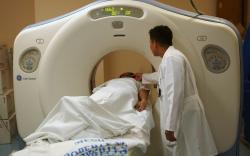Press Releases

The United States Preventive Services Task Force (USPSTF), an independent, volunteer panel of national experts in prevention and evidence-based medicine, has released a draft recommendation statement on screening for lung cancer. It says:
The USPSTF recommends annual screening for lung cancer with low-dose computed tomography (LDCT) in adults ages 50 to 80 years who have a 20 pack-year smoking history and currently smoke or have quit within the past 15 years. Screening should be discontinued once a person has not smoked for 15 years or develops a health problem that substantially limits life expectancy or the ability or willingness to have curative lung surgery.
We asked Robert A. Smith, PhD, Vice President of Screening, for his thoughts on the update.
Big picture: what do you think of the draft guideline?
The USPSTF’s draft Screening for Lung Cancer recommendation statement is a step forward based on new evidence since the release of their 2013 recommendation. It builds on the evidence from the recently published NELSON trial, which showed a significant reduction in lung cancer mortality in a population that was younger and had lighter smoking histories than included in previous studies.
What are the major differences between this draft and the current ACS guideline?
Most current lung cancer screening guidelines, including those from the American Cancer Society, are based on the population that was eligible for the U.S. National Lung Screening Trial (NLST), which published its findings nearly 10 years ago. Based on that initial study, the ACS and others recommend screening for people who currently smoke or have quit within the past 15 years between the age of 55-74 with at least a 30 pack-year history (pack-years is the number of packs per day multiplied by years of smoking), and generally being in good health.
Based on the more recent findings from the NELSON trial, USPSTF is recommending screening for people who currently smoke or have quit within the past 15 years with a 20 pack-year history instead of 30, and is lowering the age to begin screening from 55 to 50. So, the major differences between this new draft guideline from USPSTF compared to those from ACS and others is its recommendation of a younger age to start screening, a lower threshold for pack-year history, and an older age limit (extended to age 80).
How would these changes affect the potential for lung cancer screening to reduce lung cancer mortality?
It was reasonable for the initial guideline to follow the eligibility criteria used for the NLST, the only randomized trial that had been done at the time. But over time it has become clear that people with lighter smoking histories are among those who are diagnosed with lung cancer each year. The USPSTF estimates that adherence to the new guideline could lead to a 32% greater reduction in mortality compared with the previous guideline. Adherence to the current screening recommendations has not been optimal, so it will be important to make greater progress than we have to date in reaching the now larger target group eligible for lung cancer screening.
Does the ACS plan to change its guideline?
We have been following the new data since our last update, and expect to begin an update of our lung cancer screening guideline later this year. We will examine the USPSTF draft recommendation statement very carefully, along with their systematic evidence review and modeling studies, as well as any new evidence that is published in the interim. In the meantime, this appears to be an important step forward, and should provide greater confidence in the benefit of screening for lung cancer with low dose CT.
For more information on screening for lung and other cancers, see: Cancer Screening Guidelines on cancer.org